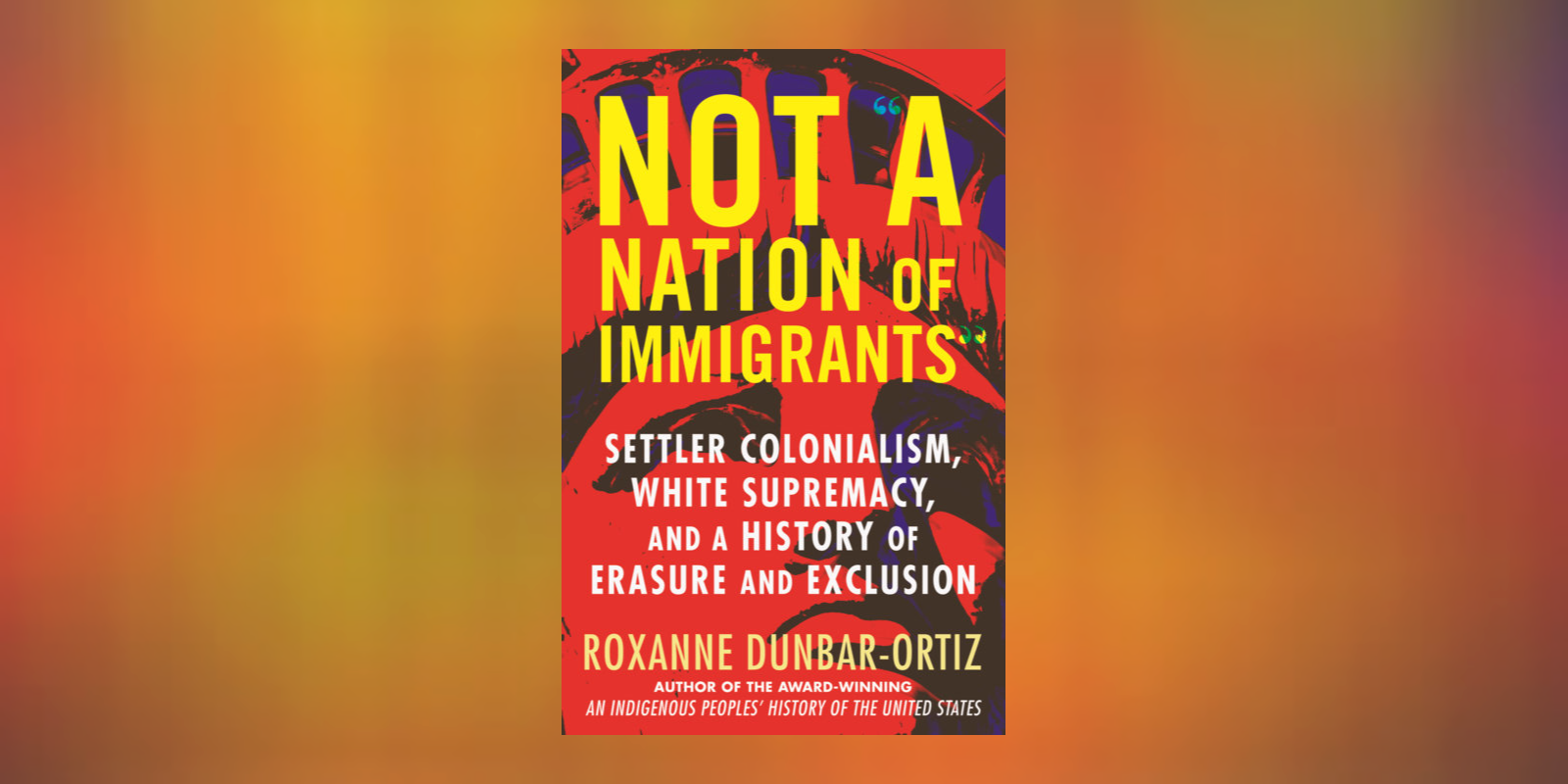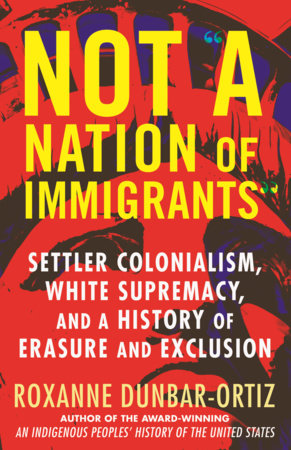Whether in political debates or discussions about immigration around the kitchen table, many Americans, regardless of party affiliation, will say proudly that we are a nation of immigrants. In this bold new book, historian Roxanne Dunbar-Ortiz asserts this ideology is harmful and dishonest because it serves to mask and diminish the US’s history of settler colonialism, genocide, white supremacy, slavery, and structural inequality, all of which we still grapple with today.
She explains that the idea that we are living in a land of opportunity—founded and built by immigrants—was a convenient response by the ruling class and its brain trust to the 1960s demands for decolonialization, justice, reparations, and social equality. Moreover, Dunbar-Ortiz charges that this feel good—but inaccurate—story promotes a benign narrative of progress, obscuring that the country was founded in violence as a settler state, and imperialist since its inception.
While some of us are immigrants or descendants of immigrants, others are descendants of white settlers who arrived as colonizers to displace those who were here since time immemorial, and still others are descendants of those who were kidnapped and forced here against their will. This paradigm shifting new book from the highly acclaimed author of An Indigenous Peoples’ History of the United States charges that we need to stop believing and perpetuating this simplistic and a historical idea and embrace the real (and often horrific) history of the United States.
In the excerpt below, Roxanne Dunbar-Ortiz explains some of the origins for the myth that our country is proudly founded by and for immigrants:
This idea of the United States as a nation of immigrants was hatched in the late 1950s, and while Kennedy was its ambassador, it came to reflect the US ruling-class response to the challenges of the post–World War II anticolonial national liberation movements, as well as civil and human rights social movements domestically. In the United States, the National Congress of American Indians (NCAI) was founded in 1944 by D’Arcy McNickle, Helen Peterson, and other longtime Indigenous activists. At the same time, African American attorneys and other professionals were developing a legal strategy for desegregating public schools, while in 1951, more radical African Americans, including Paul Robeson and members of the Civil Rights Congress, petitioned the recently established United Nations with the detailed document We Charge Genocide, based on the 1948 UN Convention on the Prevention and Punishment of the Crime of Genocide. A mass movement against segregation was emerging. Around the same time, Native American activists were contextualizing the situation of Native nations within the decolonization/national liberation context, and Mexican farmworkers were organizing in the fields, defeating the Bracero Program and forming unions.
These cracks in the racial order of settler colonialism and capitalism constituted a radical departure in a society locked down in patriarchal white domination and obsessed with “real” Americanism. At the end of World War II, the US social, economic, and political order was solidly and confidently a white patriarchal Protestant republic, dominated by corporations with worldwide investments and financial reserves, along with a massive military machine far greater than that of any other country in the world. Unionization movements, primarily made up of white workers, were seduced by home ownership and middle-class status, their unions becoming business oriented with their own profit-making privatized healthcare, while the United Kingdom and Western European states responded to militant union demands to institute universal, public healthcare. Black descendants of enslaved Africans lived under a totalitarian Jim Crow system in the former Confederate states and were ghettoized and discriminated against when they escaped the South in migrations for northern and coastal industrial urban areas that were stalked by urban police forces resembling slave patrols. Native Americans were abandoned on shrunken land bases that could not support life, forcing many to find work in nearby or faraway cities, while Congress began reversing New Deal reforms that had acknowledged the Native land base and governments. This culminated in the congressional termination of Native status and land bases in 1953, an erasure that took the Red Power movement two decades to reverse. On the other hand, Irish and Central, Southern, and Eastern European immigrants, mainly Catholics and Jews, had made gains in being accepted as equal, that is, as white. But on the West Coast, US citizens of Chinese and Mexican descent were discriminated against and subject to deportation, while US citizens of Japanese descent had been incarcerated in wartime concentration camps, stripped of their property and citizenship rights. Want ads for jobs segregated men and women as well as white and Black, with Introduction xvii lower wages for women and Black workers. Ivy League universities were overwhelmingly white and for men only, with quotas to limit the number of Jewish men.
The explosion that cracked the white republic was the 1954 US Supreme Court school desegregation decision under Chief Justice Earl Warren, who ironically, as the wartime attorney general of California, had facilitated rounding up Japanese Americans for federal incarceration. Based on decades of organizing for African American desegregation, the order for school desegregation under Brown v. Board of Education of Topeka, was a great achievement,but the backlash commenced immediately. White Citizens’ Councils organized all over the United States, linking racial integration with communism and labeling it un-American. Within three years of the Supreme Court desegregation decision, the white nationalist John Birch Society was launched by Robert Welch, the heir to the Welch candy fortune in Massachusetts, along with others such as Fred Koch, father of the Koch brothers, who, in the twenty-first century, have funded legislation and movements to end all government benefits and promote the privatization of public goods. The Supreme Court composition was the target of this white nationalist movement, using the Republican Party as the vehicle, and had largely achieved its goals with the Trump administration’s appointment of three justices, shifting the court’s ideological spectrum to five ultraconservative justices, one moderate conservative, and three liberal ones.
The promise of permanent progress was the context within which the Black civil rights movement grew and contributed momentum to other ongoing movements for liberation, including Puerto Rican independence and Native American self-determination, as well as the Mexican farmworker unionization movement of the 1960s, the women’s and LGBTQ rights movements, and the rising student anti-imperialist and anti-war movements that grew in opposition to the accelerating US war to overthrow the government of Vietnam. The counterrevolution against these advances brought Richard Nixon, then Ronald Reagan, to the presidency. By 1990, capitalism and militarism were triumphant in dissolving the Eastern European socialist bloc and organized liberation movements that had taken state power in Africa, Asia, and the Caribbean, which became shadows of their former aspirations.
The first highly visible sign of a well-organized counterrevolution inside the United States vying for political power was the evangelical antiabortion mass movement that soared following the Roe v. Wade Supreme Court decision to decriminalize abortion, in 1972. And, significantly, the relatively benign, century-old National Rifle Association was taken over by the Second Amendment Foundation, a white nationalist organization that had been founded in 1974 by Harlon Carter, who had been the border chief of the 1950s mass deportation of Mexicans in “Operation Wetback.” This is the moment when the Second Amendment became a white nationalist cause, relying on the right-wing ideology of originalism—that is, interpreting the original meaning of the US Constitution. Parallel to postwar liberation movements, the US Central Intelligence Agency ran counterinsurgent operations against national liberation movements before and after they took power in Latin America, the Caribbean, the Pacific, and Africa, while J. Edgar Hoover’s Federal Bureau of Investigation (FBI) ran similar operations against domestic movements, including COINTELPRO, a domestic counterintelligence program. Anticommunism was the connective tissue among these organizations until the socialist bloc collapsed in 1990, although anticommunism remained a social and political weapon of control domestically and internationally.
In the mid- and late 1960s and early 1970s, while the US war in Vietnam raged, the then liberal United States ruling class and its brain trust sought ways of responding to social demands while maintaining economic, political, and military domination. They settled on multiculturalism, diversity, affirmative action, and yes, the nation of immigrants ideology in response to demands for decolonization, justice, reparations, social equality, public spending on social welfare, and an end to US imperialism, counterinsurgency, and overthrow of governments. Given attempts to offset an exclusive emphasis on white settler history and the winning of the West as the nationalist triumphal narrative, “a nation of immigrants” fit the multicultural agenda. No longer was the US a “melting pot” of assimilation to whiteness but rather a many-colored quilt. Kennedy’s A Nation of Immigrants had called the United States “a nation of nations.” Despite the surging of white nationalism during the twelveyear period of the Reagan-Bush administrations, by the early 1990s, the “waves of immigrants,” “nation of immigrants,” and Native peoples as “the first immigrants” narrative Kennedy had conceived was a consensus concept as it entered public school textbooks. This neoliberalism also triggered textbook wars over history standards, the right wing pushing for and demanding a return to the original narrative, especially founding fathers iconography to support their constitutional philosophy of “originalism.”
During the nearly two centuries of British colonization of the North Atlantic coast and up to US independence, the great majority of European American settlers were Protestant Anglo-Saxon, Scots Irish, and German-speaking (before Germany was a nation-state). From 1619 onward, there was a steadily increasing number of enslaved Africans. When the United States won independence, the founders inscribed in the Constitution the requirement that citizenship could be held by white males only. Despite expressed fears, especially by Alexander Hamilton and the Federalist Party regarding immigration and the Alien and Sedition Acts, no immigration laws or procedures existed, not even during the arrival in the 1840s of 1.5 million Irish famine refugees. In 1875, the US Supreme Court declared that only the federal government, not the states, could create immigration laws and that regulation of immigration was a federal matter, though the federal immigration service was not established until 1891. Tellingly, the first federal immigration law, which created the foundation for US immigration, was the 1882 Chinese Exclusion Act. It is crucial to recognize that when and how “immigration” as such began, it was based on overt, blatant racism and a policy of exclusion, and it has never lost that taint. Although immigrant bashing is not new, and has long targeted Asian and Mexican workers, it has become a more fraught issue as it crystalized in the late twentieth century and accelerated in the early twenty-first century, targeting Mexicans, Asians, and Arab Muslims.
Yet, those who defend immigrants and immigration, mostly metropolitan liberals, often immigrants or children of immigrants themselves, employ the idea of a nation of immigrants naively without acknowledging the settler-colonial history of the United States and the white nationalist ideology it reproduces. Such advocates were caught by surprise and in shock when Mexican hating led to a successful presidential campaign in 2016, and even more surprised by the January 6, 2021, white nationalist violent takeover of the US Capitol.
The elephant in the room of immigration is the US military invasion and annexation of half of Mexican territory that spanned more than two decades, 1821 to 1848. During that same period, the eastern half of the United States was being ethnically cleansed with the forced removal of Native nations. White supremacy and settler-colonial violence are permanently embedded in US topography. The United States has a foundational problem of white nationalism that wasn’t new with Nixon or Reagan or Trump.
White nationalism was inscribed in the founding of the United States as a European settler-colonial expansionist entity, the economy of which was grounded in the violent theft of land and in racial slavery, and with settlers armed to the teeth throughout its history, presently numbering over three hundred million people with the same number of firearms in civilian hands. Yet only a third of the population own those guns, an average of eight each, and 3 percent of the population own 50 percent of the guns in civilian hands. A great majority of this minority of gun owners are white men who are descendants of the original settlers, or pretend to be.16 These descendants are most obvious in the former Confederate and border states but actually are also scattered in clusters and communities in all parts of the United States. They are the latter-day carriers of the United States’ national origin myth, a matrix of stories that attempts to justify conquest and settlement, transforming the white frontier settler into an “indigenous people,” believing that they are the true natives of the continent, much as the South African Boers regarded themselves as the “true” children of Israel, powered by Calvinism; the Calvinist Scots settlers did in Ulster, Ireland; or Jewish settlers in Palestine—all established by an imaginary God-given covenant making them the chosen peoples.






